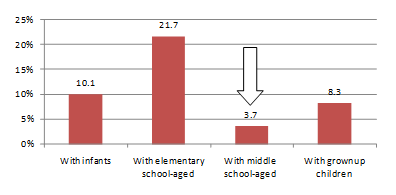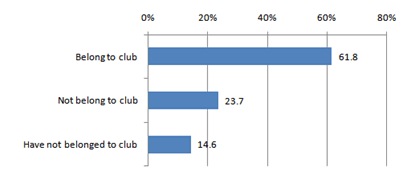M-shaped curve in family travel
It is well known that the labor force rate for women in their 20s and 30s is lower than that of other age groups because they tend to quit their jobs for marriage and childbirth. The labor force rate graph by age shows an M-shape. Similarly, the ratio of female participation in leisure activities and travel in their 30s and 40s is also low. What is the reason for that?

Yoko Hayano Lead Consultant
According to “Trends of the Travel Market 2009” complied by Japan Travel Bureau Foundation, the share of family travel with elementary school aged children is 21.7%, which is the highest among all family types. On the other hand, the share of family travel with the middle-school aged is 3.7%, which is one-sixth of the peak. Then, in the case of family with grown-up children, its share is 8.3%, which means they take more family trips than family with school-aged children.
In entering adolescence, children want to get independent from their parents and rather prefer to hang around with friends. In addition, junior high school students are so busy with school events including club activities that they may not have much time to take a trip with their parents.
About 62% of junior high school students participate in sport team or club activities nationwide (the Sasagawa Sports Foundation: Sport life of young people 2010) and almost all the students take part in after school activities in some regions of Japan.
The team and club members are expected to participate in the games, performances and recitals which often take place on Saturdays and Sundays. Furthermore, practices and rehearsals are scheduled during school holidays such as the summer vacation. Their parents find it difficult to plan a family vacation with kids who participate in school team and club activities.
Then, why not take their kids on a family trip on weekdays? Absolutely not! Parents have second thoughts about letting children get days off for family vacation, wondering if their kids may be unfavorably treated in terms of school evaluation. Indeed, some schools require students who are admitted by a recommendation not to be absent from classes for more than five days per year. If kids skip classes on school days between consecutive holidays during the ‘Golden Week’ that falls on the end of April and the beginning of May, the family can take a big trip. In reality, however, children cannot take days off easily because various school events have been scheduled in place of regular classes on those days.
Sports and club activities are good for children given the fact that they can learn social skills and have great opportunities to dedicate themselves to doing one thing. On the other hand, it is a pity that a family has to give up family vacation once their children enter junior high school. A good tradition the families have enjoyed all together ever since children were infants. Once people discard a practice, it is difficult to resume it.
Now the Japanese government has recently begun a discussion about introducing a flexible holiday system like in France. Some countries such as South Korea have already instituted school rules stipulating that students who travel with family should be exempt to responsibility for attending class. Such a system may motivate families to take a trip even after children enter junior high school, which would pick up the bottom of M-shaped curve in family vacation.
The share of family types in family travel

Source:Japan Travel Bureau Foundation
The percentage of junior-high school students belonging to sport and culture activities (Nationwide)

Source:Sasagawa Sports Foundation
